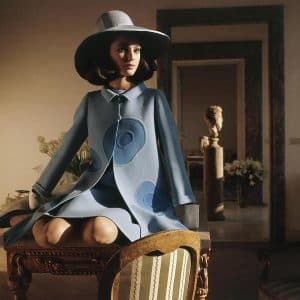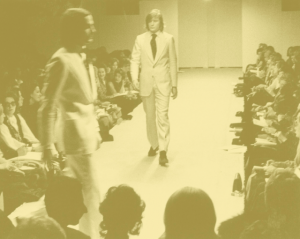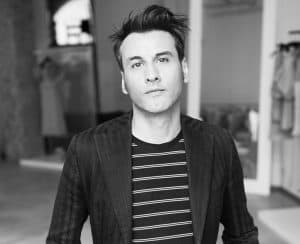Mila Schön

An Italian Fashion House founded by eponymous Mila Schön created understated, impeccably tailored haute couture worn by fashion icons like Jacqueline Kennedy but it was the House’s high-end ready-to-wear collections and innovations that put this brand at the centre of the Italian fashion world.
Index
The Origin
Brand Development
Schön Style
Famous Collections
Exhibitions
Current Situation
The Origin
Mila Schön was born Maria Carmen Nutrizio in 1916, at Trogir or Traù (Dalmatia), an Italian speaking town now in Croatia. Her parents were wealthy aristocrats. With the breakup of the Austro-Hungarian Empire at the end of World War I, Schön’s family lost their estates. The family then moved to Italy where Schön’s father managed a pharmacy. Schön married Aurelio Schön, an Austrian precious metals dealer during World War II. In the post-war period, Schön enjoyed a brief return to wealth and became a client of the most prestigious Parisian couture houses such as Balenciaga and Dior.
The family fell on hard times again and following her divorce, Schön turned to fashion industry.

Brand Development
In 1958 Mila opened her first Atelier in Via San Pietro all’Orto, Milan.
In 1965, at Giovanni Giorgini’s invitation, she presented her collection at Florence’s Palazzo Pitti in twenty-five different variations of violet, from lilac and mauve to wisteria which stirred enthusiasm and appreciation from the press and international buyers.
The year 1966 saw Mila receive the “Oscar of Fashion” from Neiman Marcus which was her first trip to the US. The same year at Gran Galà in New York, Lee Radziwill and Marella Agnelli, who adorned her designs were given first and third places in the Women’s Wear Daily poll for the best-dressed list. She also opened her new atelier in Via Montenapoleone in Milan, designed by architect François Catroux.
In late 1960s Mila started a new revolution with the creation of ‘the double-faced fabric’ made by meticulous workmanship and an absolute innovation.
In the year 1969, Mila Schön’s collection inspired by Calder was awarded “Tiberio d’oro” in Capri, Italy. The same year she created the famous ‘long-dress with Fontana-style slashes’ inspired by Lucio Fontana’s art which was photographed by Ugo Mulas. It was around this year that Mila began to construct a complete image with exclusive accessories creating a total look, eventually including handbags and shoes, lingerie and watches, perfume, swimwear and eyewear. She also designed the made-to-measure uniform for Alitalia flight crew.
Mila Schön became a renowned name during the end of 1960s and was one of the most successful couturiers of the day and many show women turned to her for clothes for their performances.
In 1971, came one of Mila’s biggest successes. The birth of menswear line Mila Schön U, along with double-faced neckties became one of the best sellers of the brand. Same year she also presented the brand’s first prêt-à–porter collection for women.
In 1973 Mila Schön became one of the first fashion houses to represent the ‘made-in-Italy’ in Japan.
In the year 1983, 25 years of Mila Schön was celebrated with a collection of High Fashion historical and contemporary pieces at Ninfeo of Valle Giulia in Rome.
In 1986, the Japanese multinational corporation Itochu invested in the registered stock of the company and in 1993 bought its entire parcel of shares. Despite this, Itochu’s role has always been only financial, with the creative and managerial side of the business in the hands of its founder. Later on, Itochu licensed the brand to the Mariella Burani Fashion Group.
The year 1992 marked the house’s first Haute Couture Show in Paris.
By 1995, the house decided to give up on haute couture and concentrate exclusively on ready-to-wear.
In 1998, the label adopted a new strategy and handed over its lines to a style studio founded by eight young creators, who were all bred and trained in-house at Central St Martin’s and the Royal College of Art in London: Cristina Barreto, Lisa Cameron, Stefano Citron, Greg Myler, Federico Piaggi, Darryl Rodriguez, Paolo Trillini and Steven Verno, each an expert in their own field.
In the year 2002 Marc Helmuth, who had more than a decade experience in Dior, as well as stints at Thierry Mugler, Yves Saint Laurent and Lanvin was chosen as the new designer. He presented his first Mila Schön collection for Spring/Summer 2003.
In 2007 the brand was acquired by Italian company Brand Extension that re-launched it with new collections designed by Bianca Maria Gervasio.
In September 2008, Brand founder Mila Schön passed away at the age of 91. The year also marked 50 years of brand Mila Schön. AltaRoma celebrated the occasion by releasing a docufilm ‘50 Mila Schön’.
In 2009 Bianca Maria Gervasio presented, the Fall Winter 2009/2010 ready-to-wear collection, which included a lot of classic Mila Schön elements like chevron and clean-cut garments with a modern twist. The collection used sheer fabrics, bright colours along with futuristic elements to make it truly modern.
Adding to the brand’s development, the Fall Winter 2011/2012 collection incorporated handcraftsmanship and complex elaborations like jacquard. This collection took people to the seventies with its silhouettes, retro jewellery and multi-coloured turbans.
For S/S 2012, Gervasio drew inspiration from ikebana, the ancient Japanese art of composing flowers. Using pure, saturated and solid colours, the brand used fantasy prints brought back from the house’s archive such as Majolica, inspired by polished Spanish tiles and Persepolis, a mosaic kaleidoscope of stripes, geometrical designs, crosses, and flowers designed in all colours.
In 2013 Alessandro De Benedetti was made the Creative Director of Mila Schön.
With the new creative head, Mila Schön opened its S/S 2014 collection with flared dresses, wide trousers, sheath dresses with glittering fringes and some sporty hints matched with geometrical patterns staying true to the brand’s DNA.
In 2016, Benedetti presented, the collection of Fall Winter 2016/2017 that included tropical-inspired patterns reinterpreted in a contemporary version, sophisticated asymmetries and de-constructed looks. This collection used some of the brightest colours like, sun yellow, electric blue, midnight blue, gun metal grey, along with subtler old pink and camel.
The Fall Winter 2017/2018 collection by Benedetti for Mila Schön took an evolutionary turn. The collection brought not just one woman but different women to the runway in terms of style. The collection sported trouser suits, duffle coat, oversized silk-embroidered sweaters, pleated dresses, animal prints, polka dot patterns and seductive suits among others. This collection presented the stories of different women, their beauty and elegance.

Schön Style
Mila Schön’s major successes came from the brand’s high-end ready-to-wear collections and the brand’s innovations notably the double-faced fabric.
The idea of Mila Schön started as the combination of Balenciaga’s austerity of cut, Dior’s versatility and a hint of Schiaparelli’s wit. All the fashion houses that Mila personally enjoyed, influenced the brand.
Schön style is characterized by graphic purity and linearity. The decade between 1960s and 1970s saw the brand take immense inspiration from the world of art, in particular Lucio Fontana’s holes and slashes and Kenneth Noland’s chevron. Art had a growing influence on Schön. Gustav Klimt’s paintings were turned into precious embroideries; Alexander Calder’s mobiles were used in the prints and Victor Vasarely’s images inspired the patterns for coats and skirt suits. Later on, the brand included more feminine and revealing styles that were becoming the norm of the time.
In recent years, the brand has evolved itself to include more powerful and well-structured garments with feminine elements that are revolutionary and speak to the future.

Famous Collections
Some of the brand’s famous collections belonged to the era of sixties and seventies, with the double-faced fabric and the famous skirt-suit. The art-inspired collections also belonged to this decade that made the brand world-renowned.
The brand created its first menswear collection in the 70s that became extremely-famous at the time and resulted in the birth of Mila Schön U, an exclusive menswear line.
In the recent years, the brand tried to adapt itself to changing times with collections like S/S 2003, where designer Marc Helmuth brought about some “coolness” to the brand for the modern, city-loving active woman.
Coming to the most recent collection, Alessandro De Benedetti’s Fall 2018 collection served as a visual love letter to the woman who started it all. The collection’s vision was modern-meets-retro, suggested by prints inspired by the Bauhaus and Futurist movements.
Some of the brand’s famous clients included, former first lady of the US Jacqueline Kennedy, socialites Lee Radziwill, Marella Agnelli and Brooke Astor. Also, Farah Diba (the empress of Iran) and Imelda Marcos (former first-lady of Philippines) wore Mila’s creations.
Exhibitions
Some of Schön’s works are held by museums such as the Metropolitan Museum of Art, New York and the Victoria and Albert Museum, London.
In September of 2008, the exhibition “Linee, colori, superfici” (lines, colours, textures) at Milan’s Palazzo Reale celebrated 50 years of the Mila Schön House and in December 2009 the Tribute Event “Mila e la Notte” was held in Trieste invited by City of Trieste, in memory of the Brand founder.
Through 2014 to 2016, some of Schön’s archive dresses and sketches were chosen to be part of the exhibitions such as “1924-2014 RAI tells Italy” (itinerant exhibition travelling through the most important cities in Italy), “The Glamour of Italian Fashion since 1945” ( held first at the Victoria and Albert Museum in London, and then St Minneapolis at the Institue of Art, The First Center of the Visual Art in Nashville), “Bellissima L’Italia dell’Alta Moda 1945 – 1968” (opened at Maxxi Museum in Rome and then at Palazzo Reale in Monza).

Current Situation
Currently, the brand’s creative director is Alessandro De Benedetti whose unique collection of Fall 2018/2019 was an ode to Mila Schön and her vision. Speaking of the collection L’Officiel magazine quoted, “It is a collection that celebrates Schön’s signature style made for the Instagram generation”.
In February of 2018, to celebrate 60th anniversary, the House owned by Itochu presented the event “Becoming Mila Schön” at Palazzo Clerici in Milan after show Fall Winter collection 2018/2019, the event included a video installation and presentation of image book with six hundred pages representing sixty years of history, essentially composed of images taken from published articles and editorial shoots, from the founding of the brand to the present day. The event is proposed to be held in parts of Asia as well.
